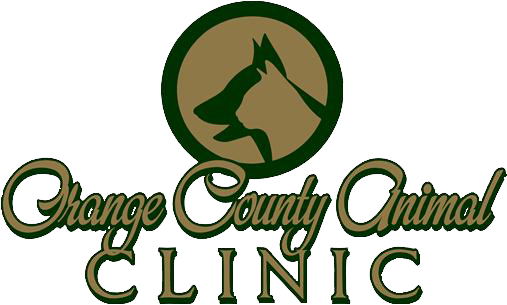Orange County Animal Clinic
Surgical Instructions
Surgical Instructions
Pre-surgical and post-op instructions for surgical patients at Orange County Animal Clinic.
Click here to view or print a PDF copy of these instructions.
Pre-Surgical Instructions
Your pet must have no food, including treats, after 10 p.m. the night before surgery. They may have water up to the time of check-in on the morning of surgery. These precautions are taken to reduce the chance of your pet vomiting during the procedure and aspirating while under anesthesia. If your pet has food after 10 p.m., it will be necessary to cancel the procedure and reschedule for their safety.
Drop-Off
We ask that you drop your pet off on the morning of surgery between 7:30 and 9:00 a.m. If it is more convenient for you, you can drop it off before 5 p.m. the night before at no additional cost. Please allow 10-15 minutes for check-in. When you get here, we will have consent forms for you to sign and confirm the procedures being performed and any additional services you might want done while your pet is in our care.
Surgery Options
We offer optional services with each surgical procedure to provide you with peace of mind and your pet with the best medicine we can. These are at an additional cost, and you will provide consent at check-in.
- Pre-Anesthetic Bloodwork – Certain medical conditions can create complications for pets under anesthesia. This is why Dr. Cooper recommends a preoperative blood panel for your pet. It will check major organ function, blood counts, and electrolyte levels. This information can assist Dr. Cooper in making decisions that will make surgery as safe as possible for your pet.
- Aesculight Surgical Laser – With the surgical laser, there will still be an incision, but the laser will make a quicker and less painful recovery for your pet. The surgical laser cauterizes vessels as it cuts, resulting in less blood loss. It also makes a finer cut, damaging fewer cells. For our surgical patients over 30 pounds, surgical lasers will be included in the price of the spay or neuter cost. We have found fewer complications arise with pets of this size with the surgical laser.
- K-laser Post Surgical Treatment – The K-laser treatment increases blood flow to the wound, which allows the body’s immune cells to get to the area where they are most needed. The K-laser decreases inflammation and stimulates cytokines that speed the healing process. In short, therapeutic laser treatments promote healing! Doses of medication are reduced in pets receiving laser treatments for wounds due to the pain-relieving properties of the laser and the increased blood flow. K-laser helps your pet heal faster and with less pain!
Post Surgical Instructions
Your pet has undergone a surgical procedure and will experience some trauma. The following will help answer the most common questions after a surgical procedure. An animal’s pain threshold is much higher than a human’s. Therefore, animals do not exhibit as much discomfort following surgery. Today, your pet was given a pain injection as part of the surgical recovery process. Do not allow excessive playing, jumping, or running. This may delay the normal healing process.
Recovery
Each animal recovers from anesthesia at a different rate. Some animals return to normal within 24 hours, while others may take 3-4 days to recuperate fully. Your pet will not be discharged from the hospital if they cannot walk out; however, some animals may stagger slightly upon release. Your pet will recover from surgery faster if the convalescent time is spent at home. Surgical patients must be kept in a warm environment as it is normal to have difficulty maintaining normal body temperature after entering anesthesia. Remember: not too hot, not too cold! Pets that have had surgery should be confined indoors for 24 hours because after being under anesthesia, they may not have a clear head and may be unable to determine safety from unsafe situations.
Feeding
Your pet may eat supper the evening it returns home. You may give a minimal amount of food and a minimal amount of water. If your pet does okay with this meal and doesn’t vomit, they may have several small meals through the evening. However, if your pet vomits after eating, limiting intake to small amounts of ice chips until morning is best.
The Incision
You must check the incision at least once daily. Animals will often lick at the incision site. This can result from itching from being closely shaven or irritation from the suture material. DO NOT LET YOUR PET LICK EXCESSIVELY AT THE INCISION SITE. If your pet is licking, you must return to the clinic to get an e-collar (cone) for your pet to wear to prevent further licking.
A small amount of hemorrhage or swelling occasionally occurs at the incision site. This happens when blood pools under the skin. A drop or two may discharge through the sutures when the animal moves. If excessive bleeding continues for more than 24 hours, please call our office.
Occasionally, a hard lump will appear at the incision site. This is often a reaction to the suture material or can result from blood pooling under the skin. If it gets noticeably larger, please call us.
Your pet should not have a bath or swim until the incision is healed completely. This usually takes 10-14 days on standard surgical procedures.
Special instructions for cats that have been declawed:
It is essential that shredded paper, rather than litter, is used in the litter box for two weeks following surgery.
Unless otherwise noted, all sutures are absorbable; therefore, no return visit for suture removal is needed.
You must not administer human products such as aspirin, Tylenol, Advil, Aleve, or any other over-the-counter pain relievers (including herbs). These products can be harmful and even toxic to your pet!
